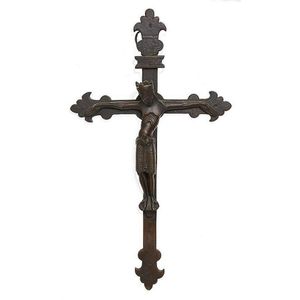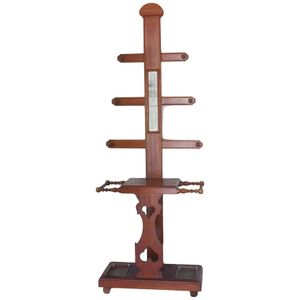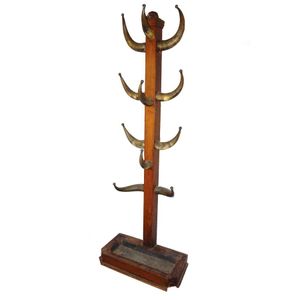A carved and applied wooden Arma Christi Cross, Mexican, 18th century. 226 cm high, 105 cm wide. The imagery of the Cross, accompanied by the instruments of the Passion (Arma Christi) was imported to the New Spain from Europe by Franciscan missionaries.1 The Franciscans, following the example of their titular saint, were especially devoted to the Passion of Christ and used art as a means of prompting the faithful to contemplate the various stages of the crucifixion drama as though it were occurring before their eyes. Arma Christi crosses were an effective tool used to help visualize the individual scenes and missionaries used these in their personal devotion as well as a means of assisting the pious efforts of their congregations. Folk art examples such as this were also probably used in Passion Week processions. This example possibly dates from the nineteenth century and is especially rich in the symbolic elements of the Passion story. The objects attached to the cross represent various stages of the Passion and especially instruments of Christ?s torments that are to be interpreted as weapons (arma) in the triumph over death. A rooster surmounts the cross, referring to Christ?s prediction that Peter would deny him three times before the cock crowed (Matthew 26:34). Below this, an image of the sun rising above the Titulus Crucis - INRI (Iesus Nazarenus Rex Iudaeorum) also references Peter?s denial as well as the symbolism of the Risen Christ. This might also be read as a symbolic image of the New Testament (although Arma Christi crosses often have this combined with an image of the moon, representing the Old Testament) or as a reference to the eclipse that occurred after the crucifixion. Included is also a representation of a money bag, indicating the betrayal by Judas in exchange for silver. Hand suggests the slapping of Christ by the guard. Unusually, this is mirrored at the either end of the horizontal bar; it is normal for only one hand to be shown. To the right are representations of: the hammer and nails; a vessel, perhaps a representation of gall or vinegar; the dice used by the soldiers to cast lots for Christ?s robe; two whips (again, it is unusual to see two rather than one of the instruments of flagellation - the artist appears to have been fond of symmetry!); the ladder representing the deposition from the cross; two sticks - perhaps indicating the reed with which vinegar was given to Christ (although no representation of the sponge is present) and the reed placed like a scepter in his hand as a gesture of mockery. The panel at the crossing is not identifiable but may originally have contained a small image of Christ. Next to this comes images of: the lance; the column to which Christ was tied and flagellated; a chalice, referencing the cup of the Last Supper as well as the Holy Grail; Peter?s sword, the pincers; and the keys of the kingdom of heaven. The lower section of the vertical bar contains a crown. It is more common for the crown of thorns to be represented in such imagery, however here we have the crown referring to Christ as the triumphant ruler over death as well as the mocking inscription of the titulus crucis. Below this is a representation of the wound in Christ?s side followed by the sepulchre. The skull and crossed bones beneath this are memento mori as well as referring to the legend of the True Cross that the tree from which the Cross was made grew from the grave of Adam. A representation of the purple robe used to mock Christ completes this complex array of Passion references. Dr. Bronwyn Stocks 1 Octavio Paz, Mexico: Splendors of Thirty Centuries, (Metropolitan Museum of Art, New York, 1990) p.250
You must be a subscriber, and be logged in to view price and dealer details.
Subscribe Now to view actual auction price for this item
When you subscribe, you have the option of setting the currency in which to display prices to $Au, $US, $NZ or Stg.
This item has been sold, and the description, image and price are for reference purposes only.
- Memento Mori - A memento mori is an artistic or symbolic reminder of mortality. Literally translated from the Latin it reads: "remember that you will die". They are found in art, architecture, horology, music and jewellery.
- Chalice - A chalice is a large cup or goblet that is used in religious ceremonies, particularly in Christian liturgical traditions. It is typically made of precious metal such as gold or silver, and is used to hold wine during the Eucharist, which is the central sacrament of the Christian Church. The chalice is also called the "cup of salvation" and is a symbol of Jesus' sacrifice on the cross.
In the Christian tradition, the chalice is a symbol of the blood of Jesus Christ, which is offered to the faithful as a means of grace and salvation. The chalice is used to hold the wine that is consecrated during the Eucharist and is considered to be a sacred object.
In the liturgical celebration of the Eucharist, it's passed around to the faithful, and the believer drinks from it to partake in the sacrament. Chalices are also used in other liturgical celebrations such as baptism, confirmation and anointing of the sick.
Chalices come in different shapes and sizes, from simple cups to highly ornate and decorative vessels, some of them are adorned with precious stones and intricate engravings. Chalices can also be used for other purposes, such as for holding holy water for baptism, or for the distribution of ashes on Ash Wednesday.
This item has been included into following indexes:




